Sit spots, sound walks and yoga
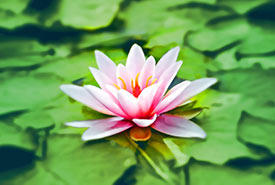
Water lily in a pond (Photo by Pexels, CC0)
Connecting with nature, even for five minutes a day, can have tremendous benefits for your health and wellness while helping to reinforce positive new habits. Nature is quiet and resilient and provides an opportunity for us to re-connect with ourselves and reflect on solutions during these challenging times. It’s time to put yourself first — be intentional and carve out time in your day or week to dedicate to getting outside and trying something new.
Related content:
For this nature therapy blog, I am going to dive into three activities that you can do while out in nature that require little to no preparation or materials. You can do these anytime, anywhere, and I guarantee that you will instantly feel the benefits both physically and mentally.
Activity #1: Sit spot
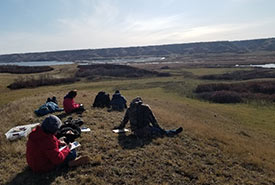
Pasqua Lake, SK (Phoot by NCC)
A sit spot is a favourite place in nature that you can visit regularly to relax, be present and give yourself the chance to reflect on the stressors in your life and ways to move forward. It is also the chance to observe patterns as you expand your senses and study patterns of local plants, birds, trees, animals, etc. What you see, hear and experience in nature can improve your mood in a moment.
To choose your sit spot, find a safe and comfortable spot outdoors that feels right to you. Mindfulness isn’t about trying to forget about what is weighing heavily on you, but rather creating a space for those stressful feelings so that you can find the tools to help you work through them. Use nature as one of those tools.
Guiding ideas and questions
These questions are only meant to be starting points. Feel free to let your mind wander, and write down other thoughts, ideas, observations, intentions and next steps. You can write down or draw whatever is meaningful to you in the moment, or you can just think in your head or talk out loud. Be honest with yourself — no one else will be reading this. It is only for you.
1) Sit or lay down, whatever feels most comfortable. Maybe do some gentle stretching if it feels right. Close your eyes and take at least five deep breaths.
2) Write or draw some of the plants or natural things that you see within an area encompassed by your outstretched arms, or the wildlife that you can see or hear, both near and far. Go through your senses — what do you see? What can you touch? What do you hear? What can you smell?
3) What do you find hard to describe? Is it how the wind or sun feels on your face, or how something you hear or see reminds you of something else. Maybe a question has popped into your head — maybe what something’s role in nature is?
4) What is weighing heavily on your mind right now and why?
5) Set an intention for yourself, something that you would like to do for yourself or work on. Reflect on the obstacles that might be in your way and what you can do to overcome them.
Activity #2: Sound walks
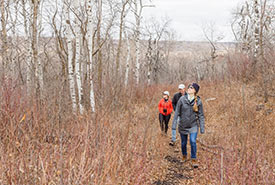
Fairy Hill, SK (Photo by Carey Shaw)
Heather Peat Hamm is a grassland plant ecologist specializing in species at risk and she creates science illustrations. She is also a writer and loves exploring sound ecology in natural environments. I reached out to her after she posted about sound walks on social media. After I asked her what a sound walk is, I knew more people needed to know about this activity.
Kayla (KB): What is a sound walk?
(Heather Peat Hamm) HPH: A sound walk is simply any walk that focuses on listening to the environment, no matter where you are. Sound ecology has become a field of study to understand how the audio environment affects different organisms. The complexity of sound can be separated into biophony (sounds of biological organisms), geophony (sounds of the physical landscape, such as wind or tumbling water) and anthrophony (sounds from humans or human constructs).
KB: How can someone go for a sound walk?
HPH: A sound walk requires nothing more than attention to sounds and a place to walk. If you are in a city, you can explore different areas (your favourite creek, busy downtown, your backyard, an open space) and notice what the sounds are and how they change as you move through the environment. Take time to notice how different environments might reflect sound, or muffle sound, or sound like something entirely different than you’d expect.
I recommend that during your walk you take time in different locations to stand in a safe place and close your eyes in order to listen more attentively. Our world is inundated with visual information, and humans tend to go for visual information first. By closing your eyes, your other senses become heightened. I would even suggest walking with a friend on level ground and taking turns leading each other so you can close your eyes and listen to how the sound environment changes as you move through it.
KB: What is your favourite part about going for a sound walk?
HPH: My favourite part of a sound walk is a toss-up between my (very) early morning walks when the prairie birds begin their raucous chorus, and taking someone for a sound walk and seeing their reaction when they really start to listen to everything around them. Our mind filters so much, just to keep sane in our noisy, modern environments, that we are often astounded at the complexity of the audible experience of our daily lives.
KB: What would you say to someone who is thinking about taking up an activity like this in nature but isn’t sure how to start?
HPH: I would suggest simply go to a place where they are comfortable and safe, and start by listening in one place, then moving to another. Eventually they can learn to move through their environment with their focus on the audible experience. It is like meditation in that if you lose your focus, simply accept that and refocus on the sounds around you. Often you can hear more in the very early mornings even in the city, before traffic and human activity overwhelm the sounds of nature around us.
Activity #3: Yoga and meditation
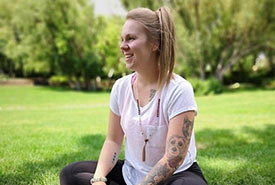
Krista Bannan (Photo by Robin Hilton)
Krista Bannan is a yoga instructor in Regina where she started her own yoga studio, Be Nice Yoga, which currently operates virtually. She is also undertaking the Metta Way, a project to send out loving kindness through creative projects, yoga teachings and classes, and through conversations.
Kayla: What got you into and hooked on yoga?
Krista Bannan (KB): A doctor I was seeing at the time suggested that I try out yoga after dealing with severe anxiety and panic attacks when I was in my early twenties. At first, I thought it was silly to do long-held postures and focus on my breath. But as I dove deeper into the practice, and worked on my understanding of it, I started to feel this connection to yoga that I hadn’t felt to anything else before.
Kayla: What are the benefits of yoga on our mental and physical well-being?
KB: The benefits of yoga are endless, and I have seen a personal transformation over the past seven years of practicing. I am patient, calmer, loving, gentler and more accepting of myself. My mental health has also improved significantly. I was anxious and experiencing panic attacks. Since starting yoga, my panic attacks are fewer and the anxiety that I experience is fleeting in comparison.
Physically, I am much more in tune with my body and more able to stretch and move with ease. Yoga is moving our body in unison with our breath and the healing abilities of that union are extraordinary.
Kayla: How can yoga be practised outdoors?
KB: The beautiful thing about practising yoga outdoors is the connection to Mother Earth and experiencing the healing energy of fresh air and nature. You can feel the pulse of the Earth beneath your feet, even if you are using a mat outdoors. Surrounding yourself with the sound of birds chirping or wind blowing can help deepen the connection you feel to your practice. It is incredible how present you can feel outside, without four walls of a studio containing you.
Kayla: How can yoga in nature help us through these difficult times?
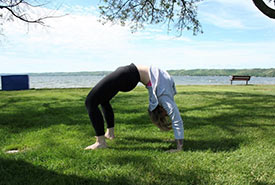
Full wheel pose (Photo by Robin Hilton)
KB: Yoga is the Sanskrit word for union. And when we are in union with nature, our breath and our body, the healing impacts are indescribable. During these difficult times, it can be easy to feel disconnected from ourselves and others, so activities that invite us into union will ultimately help us feel connected. Doing yoga outdoors, sitting outside and listening to the birds chirp, or writing or journaling on your balcony are beneficial tools in establishing the sense of connection that we are craving right now.
Steps to take your yoga or meditation practice outdoors:
1. Find a spot that you feel comfortable and safe (such as your balcony, backyard, park, etc.), keeping social distancing in mind in public.
2. Set your intentions. Ask yourself, “Why am I doing this practice?” Having clear intentions will allow you to practise presently and be aware of the purpose of your practice. Your intention can be as simple as to notice your breath.
3. Lay your mat and any props down and start the practice with a grounding exercise. Feel your sit bones root into the earth and pull that grounding energy all the way up into the body. Breathe and notice your breath as it flows in and out, feeling present.
4. Start your practice with awareness, presence and a sense of ease. If you want to follow along with a video, check out Krista’s YouTube page.
5. Finish your practice with a gratitude moment for Mother Earth and thank yourself for spending the time in a self-care ritual.
We don’t always need to take such big steps that it becomes too overwhelming when trying something new. Start simple and enjoy the journey!




